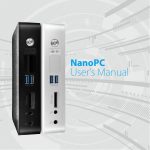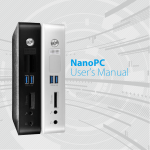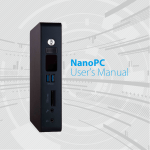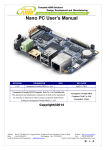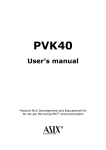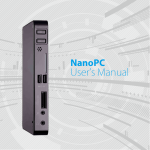Download Foxconn AT-7300 barebone
Transcript
NanoPC User’s Manual Safety Notice: CA UT IO N Trademark: All trademarks are the property of their respective owners. Version: User’s Manual V1.0 for NanoPC. Symbol description: Note: Refers to important information that can help you to use NanoPC better, and tells you how to avoid problems. UT CA IO N Caution: Indicating a potential risk of hardware damage or physical injury may exist. WEEE: The use of this symbol indicates that this product may not be treated as household waste. By ensuring this product is disposed of correctly, you will help prevent potential negative consequences for the environment and human health, which could otherwise be caused by inappropriate waste handling of this product. For more detailed information about recycling of this product, please contact your local city office, your household waste disposal service or the shop where you purchased this product. © All rights reserved. All trade names are registered trademarks of respective manufacturers listed. All images are for reference only, please refer to the physical product for specific features. Before using this product, please read the below safety notice carefully, this will help to extend the product’s lifecycle, and work normally. ■ ■ ■ ■ ■ ■ ■ ■ ■ When NanoPC is working, please make sure its ventilation system is working. The power adapter is dissipating heat during normal use, please be sure not to cover it and keep it away from your body to prevent discomfort or injury by heat exposure. Please use the power adapter that comes with the product’s package, wrong power adapter may damage your device. Make sure all the peripherals are properly connected before using NanoPC. This product should only be used in an environment with ambient temperatures between 0°C and 40°C. Always shut down the computer before installing or uninstalling the peripheral which does not support hot plug. Disconnect all peripherals before servicing or disassembling this equipment. Please do not disassemble this product by yourself, any disassembly not approved by the original manufacturer may result in malfunction, and void warranty. Risk of explosion if battery is replaced by an incorrect type, please dispose of used batteries according to the instructions. Package Contents TABLE OF CONTENTS Introduction 1-1 Front Side View....................................................................................................... 2 1-2 Back Side View........................................................................................................ 4 NanoPC Seat Base Screws, Mini PCIe Half Card Support Bracket, Magnet Rubber Foot Placement and connecting 2-1 Placement of NanoPC............................................................................................ 7 In Seat Base.............................................................................................................. 7 On the desk............................................................................................................... 7 2-2 Connection of NanoPC........................................................................................... 8 Connect display......................................................................................................... 8 Connect USB devices............................................................................................... 9 Power Adapter Power Cord Easy Guide Connect network cable.............................................................................................. 9 Connect power cord................................................................................................ 10 BIOS Setup Enter BIOS Setup........................................................................................................ 12 Main............................................................................................................................. 13 Advanced..................................................................................................................... 14 USB Flash Disk DVI-VGA Adapter Miscellaneous.......................................................................................................... 15 Integrated Peripherals............................................................................................. 16 SATA Configuration................................................................................................. 17 We DO NOT guarantee it is in compliance with the Safety Certificates if you add on an extension cable to NanoPC USB Flash Disk in the package. Power........................................................................................................................... 19 Security........................................................................................................................ 20 BootOptions................................................................................................................. 21 Save & Exit.................................................................................................................. 23 Install OS 4-1 Install Windows 7/8................................................................................................ 26 4-2 Install Drivers......................................................................................................... 30 Utility Fox WINFLASH........................................................................................................... 32 1. Local Update....................................................................................................... 32 2. About & Help....................................................................................................... 34 Introduction ■ Front Side View ■ Back Side View INTRODUCTION INTRODUCTION 1-1 Front Side View 1 1 Power button with Power indicator LED Press to turn your NanoPC on or off, the LED can indicate your system states. 2 Speaker 3 USB 3.0 port This USB port supports the USB 3.0/2.0/1.0 specification. Use this port for USB devices such as keyboard, mouse, USB printer, USB flash drives and hard disk drives, etc. As to Windows 7 system, you need to install the USB 3.0 driver in NanoPC USB Disk before using it. 4 Multi-Function card reader This memory card reader supports SD/SDHC/SDXC/MS/MS Pro/MMC memory cards used in devices like digital cameras, mobile phones, Media players and so on. 5 Microphone / SPDIF in port Connects to a microphone or playback devices with optical connectors (3.5mm jack). SPDIF function requires additional adapter and adapter cable. 6 Headphone Connects to a headphone. 7 Kensington lock Attach a Kensington security system or a compatible security lock to secure your NanoPC in place. 2 3 4 5 6 7 2 3 INTRODUCTION INTRODUCTION 1-2 Back Side View 1 1 USB 2.0 port This USB port supports the USB 2.0/1.0 specification. Use this port for USB devices such as keyboard, mouse, USB printer, USB flash drives and hard disk drives, etc. 2 USB 3.0 port This USB port supports the USB 3.0/2.0/1.0 specification. Use this port for USB devices such as keyboard, mouse, USB printer, USB flash drives and hard disk drives, etc. As to Windows 7 system, you need to install the USB 3.0 driver in NanoPC USB Disk before using it. 3 DVI DVI port Connect monitor or TV that uses DVI connector to this port. By using the DVI to VGA adapter that comes with your product, you can also connect a VGA-compatible devices such as a monitor or projector. 4 HDMI HDMI port The HDMI (High-Definition Multimedia Interface) port supports Full-HD display devices. Connect monitor or TV that uses HDMI connector to this port. 2 3 4 5 RJ-45 LAN port Supports 10/100/1000Mb/s Ethernet network. Connect network cable to access Internet. 6 Line out / SPDIF out port Connects to powered analog speakers or recording devices with optical connectors (3.5mm jack). SPDIF function requires additional adapter and adapter cable. 7 Power input port Connect power cord that come with your product. 5 6 7 4 5 PLACEMENT AND CONNECTING 2-1 Placement of NanoPC In Seat Base Place your NanoPC into the groove of the Seat Base. Placement and connecting ■ Placement of NanoPC ■ Connection of NanoPC On the desk Fit your NanoPC with Magnet Rubber Foot, and put it on the tabletop directly. 7 PLACEMENT AND CONNECTING PLACEMENT AND CONNECTING 2-2 Connection of NanoPC Connect USB devices Connect display Connect a display or TV that has HDMI port or VGA port to your NanoPC. You can connect a VGA display to the DVI port by using the DVI-VGA adapter. Connect USB devices to the USB ports, for example, mouse, keyboard devices. As to Windows 7 system, you need to install the USB 3.0 driver in NanoPC USB disk before using the USB 3.0 ports. Connect network cable Connect one end of a network cable to the RJ-45 LAN port, and the other end to a hub or switch. Please use the customized DVI-VGA Adapter that comes with your NanoPC to get a higher resolution on your VGA display. 8 9 PLACEMENT AND CONNECTING Connect power cord Connect the power adapter to the power input port of the NanoPC, and then press the power button to start it. 2 BIOS Setup 3 UT IO N 1 CA 10 The power adapter is dissipating heat during normal use, please do not cover it and keep it away from your body to prevent injury from heat exposure. ■ Enter BIOS Setup ■ Main ■ Advanced ■ Power ■ Security ■ BootOptions ■ Save & Exit BIOS SETUP Enter BIOS Setup BIOS SETUP Main The BIOS is the communication bridge between hardware and software, correctly setting up the BIOS parameters is critical to maintain optimal system performance. Power on the computer, when the message “Press <Del> to enter setup. Press <F11> to enter boot menu.” appears at the bottom of the screen, you can press <Del> key to enter Setup. Main Processor Intel(R) Core(TM) i5-3317U CP Core Frequency Count Chipset Intel PCH SKU Name We do not suggest that you change the default values in the BIOS Setup, and we shall not be responsible for any damage which resulted from the change you made. Use the arrow right/left keys to select a specific function and go to the submenu. Each function is explained below: Main It displays the basic system configuration, such as CPU Name, memory size, system date, time and so on. They all can be viewed or set up through this menu. Advanced The advanced system features can be set up through this menu. Power All the items related with Green function features can be setup through this menu. Security The Administrator/User password can be set up through this menu to prevent unauthorized use of your computer. If you set a password, the system will ask you to key in correct password before boot or access to Setup. BootOptions Boot features can be set up through this menu. You can set the boot device priority and enable “Quiet Boot” feature here. Save&Exit The optimal performance settings can be loaded through this menu. However, it may offer better performance in some ways (such as less I/O cards, less memory ...etc.), still, it may cause problem if you have more memory or I/O cards installed. It means, if your system loading is heavy, set to optimal default may sometimes come out an unstable system. What you need now is to adjust BIOS setting one by one, trial and error, to find out the best setting for your current system. You also can save or discard the changes and exit BIOS setup here. 12 Aptio Setup Utility - Copyright (C) 2012 American Megatrends, Inc. Advanced Power Security BootOptions Save & Exit System BIOS Project Version Build Date EC Version System Memory Memory Frequency System Memory Size C25F1D17 11/23/2012 12.F1.05 1.70 GHz 2 HM76 1333 Mhz 4096 MB (DDR3) System Date[Wed 11/23/2012] System Time [16:06:12] Access Level Set the Date. Use Tab to switch between Date elements. Administrator ↑ ↓→ ←: Move Enter: Select +/-: Change Opt. ESC: Exit F1: General Help F2: Previous Values F3: Optimized Defaults F4: Save & Exit Setup F7: Load User-defined Defaults F8: Save as User-defined Version 2.15.1231. Copyright (C) 2012 American Megatrends, Inc. ►System Date <weekday><month><date> <year> format. Day—weekday from Sun. to Sat., this message is automatically displayed by BIOS (Read Only). Month—month from 1 to 12. Date—date from 1 to 31. Year—year, set up by users. Use [ENTER], [TAB] or [SHIFT-TAB] to select a field. Use [+] or [-] to input the value. ►System Time This item allows you to configure the desired time. Use [ENTER], [TAB] or [SHIFT-TAB] to select a field. Use [+] or [-] to input the value. The three fields of the setting are <hour> : <minute> : <second> respectively. ►Access Level It displays your current access level. If you enter system with a user password, it will display “User”. If 13 BIOS SETUP BIOS SETUP no password is set or you enter system with administrator password, this item will display “Administrator”. Miscellaneous Main Advanced Main [off] Select the keyboard NumLock state Aptio Setup Utility - Copyright (C) 2012 American Megatrends, Inc. Advanced Power Security BootOptions Save & Exit ▶Miscellaneous ▶Integrated Periperals ▶SATA configuration Miscellaneous ↑ ↓→ ←: Move Enter: Select +/-: Change Opt. ESC: Exit F1: General Help F2: Previous Values F3: Optimized Defaults F4: Save & Exit Setup F7: Load User-defined Defaults F8: Save as User-defined Aptio Setup Utility - Copyright (C) 2012 American Megatrends, Inc. Advanced Power Security BootOptions Save & Exit Bootup Num-Lock Version 2.15.1231. Copyright (C) 2012 American Megatrends, Inc. ↑ ↓→ ←: Move Enter: Select +/-: Change Opt. ESC: Exit F1: General Help F2: Previous Values F3: Optimized Defaults F4: Save & Exit Setup F7: Load User-defined Defaults F8: Save as User-defined Version 2.15.1231. Copyright (C) 2012 American Megatrends, Inc. ► Bootup Num-Lock This item defines if the keyboard Num Lock key is active when your system is started. The available settings are: On and Off (default). ► Miscellaneous/Integrated Periperals/SATA configuration Press<Enter>to go to relative submenu. 14 15 BIOS SETUP BIOS SETUP Integrated Peripherals Main SATA Configuration Aptio Setup Utility - Copyright (C) 2012 American Megatrends, Inc. Advanced Power Security BootOptions Save & Exit PCH Azalia Configuration Azalia[Enabled] CIR Controller Configuration CIR Controller [Disabled] Control Detection of the Azalia device. Disabled = Azalia will be unconditionally disabled Enabled = Azalia will be unconditionally Enabled Main Aptio Setup Utility - Copyright (C) 2012 American Megatrends, Inc. Advanced Power Security BootOptions Save & Exit SATA Controller(s) SATA Mode Selection Port 0 Port 1 Intel(R) Rapid Start Technology Intel(R) Rapid Start Technology ↑ ↓→ ←: Move Enter: Select +/-: Change Opt. ESC: Exit F1: General Help F2: Previous Values F3: Optimized Defaults F4: Save & Exit Setup F7: Load User-defined Defaults F8: Save as User-defined Enable or disable SATA Device. [Disabled] ↑ ↓→ ←: Move Enter: Select +/-: Change Opt. ESC: Exit F1: General Help F2: Previous Values F3: Optimized Defaults F4: Save & Exit Setup F7: Load User-defined Defaults F8: Save as User-defined Version 2.15.1231. Copyright (C) 2012 American Megatrends, Inc. ►Azalia This item is used to control the detection of Azalia device. ►CIR Controller This item is used to enable or disable the CIR controller. 16 [Enabled] [AHCI] [Enabled] [Enabled] Version 2.15.1231. Copyright (C) 2012 American Megatrends, Inc. ► SATA Controller(s) [Disabled] : Disable SATA Controller. [Enabled] : Enable SATA Controller. ► SATA Mode Selection This item is used to set the operation mode of your SATA ports. [IDE] - This configures the SATA ports to support IDE mode. [AHCI] - The Advanced Host Controller Interface (AHCI) specification describes the register level interface for a Host Controller for Serial ATA. The specification includes a description of the hardware/software interface between system software and the host controller hardware. AHCI provides more advanced features including SATA features, but some SATA drives may not support AHCI, unless they are labeled with AHCI support in its specification. If your motherboard supporting AHCI, and you have a SATA device, which also supports AHCI, then 17 BIOS SETUP you can select IDE option to have fair performance, or you can select AHCI to get its best performance. ► Port 0/Port 1 This item is used to enable or disable SATA port 0/1. ► Intel(R) Rapid Start Technology This item is used to enable or disable the Intel(R) Rapid Start Technology. BIOS SETUP Power Main Aptio Setup Utility - Copyright (C) 2012 American Megatrends, Inc. Advanced Power Security BootOptions Save & Exit Restore On AC Power Loss Deep Sleep Support [Last State] [Enabled] Set the restore on AC power loss function. ↑ ↓→ ←: Move Enter: Select +/-: Change Opt. ESC: Exit F1: General Help F2: Previous Values F3: Optimized Defaults F4: Save & Exit Setup F7: Load User-defined Defaults F8: Save as User-defined Version 2.15.1231. Copyright (C) 2012 American Megatrends, Inc. ► Restore on AC Power Loss This item is used to set which state the PC will take with when it resumes after an AC power loss. ► Deep Sleep Support This item is used to enable or disable Deep Sleep Support function. When entering deep sleep mode system(S4/S5) only can wake up from power button. ► Lan Wakeup This item is used to enable or disable LAN wakeup function. it appears only when the “Deep Sleep Support” is disabled. 18 19 BIOS SETUP BIOS SETUP Security BootOptions Main Aptio Setup Utility - Copyright (C) 2012 American Megatrends, Inc. Advanced Power Security Security BootOptions Save & Exit Administrator Password Status User Password Status Installed Not Installed Change Supervisor Password Change User Password Security option [Setup] ME Flash Write Protect [Enabled] Main ↑ ↓→ ←: Move Enter: Select +/-: Change Opt. ESC: Exit F1: General Help F2: Previous Values F3: Optimized Defaults F4: Save & Exit Setup F7: Load User-defined Defaults F8: Save as User-defined Version 2.15.1231. Copyright (C) 2012 American Megatrends, Inc. ► Change Supervisor Password This item is used to install or change supervisor password. ► Change User Password This item is used to install or change user password. Only when there exists an Administrator password, then this setting can be activated. ► Security option To protect the BIOS from being changed by the unauthorized users, there is a security option provided for your choice. Only when there exists an Administrator password, then this setting can be activated. [setup]:A password will be required to enter the BIOS.(Only check password when enter setup) [Always]:A password will be required to enter both the system and BIOS. (Always check password) ► ME Flash Write Protect To protect the ME BIOS, there is a ME BIOS write-protection mechanism provided to prevent BIOS FLASH tool being improperly used to update ME BIOS. 20 Aptio Setup Utility - Copyright (C) 2012 American Megatrends, Inc. Advanced Power Security BootOptions BootOption Save & Exit Launch CSM Launch PXE OpROM policy Valid Keys: (1)a-z (A-Z) (2)0~9 (3)11 special keys:-=[];,./ (4)key pad:0-9 support and 5 special keys FIXED BOOT ORDER Priorities 1st Boot Device 2nd Boot Device 3rd Boot Device 4th Boot Device [Hard Disk] [CD&DVD] [Removable Device] [LAN] ▶Hard Disk Drive Priority ▶Optical Disk Drive Priority ▶Removable Device Priority ▶Network Device Priority [Press [Press [Press [Press Quiet Boot Boot Menu [Disabled] [Enabled] [Enabled] [Do not launch] Enter] Enter] Enter] Enter] This option controls if CSM will be launched ↑ ↓→ ←: Move Enter: Select +/-: Change Opt. ESC: Exit F1: General Help F2: Previous Values F3: Optimized Defaults F4: Save & Exit Setup F7: Load User-defined Defaults F8: Save as User-defined Version 2.15.1231. Copyright (C) 2012 American Megatrends, Inc. ► Launch CSM This item controls if CSM will be launched. WARNING: This option is for advanced users. ► Launch PXE OpROM policy This item controls the execution of Legacy PXE OpROM. ► 1st/2nd/3rd/4th Boot Device These items are used to set the system boot order. ► Hard Disk Drives BBS Priorities/Optical Disk Drive BBS Priorities/Removable Device BBS Priorities/ NETWORK Device BBS Priorities Press <Enter> to go to its submenu. Use this items to specify the boot device priority sequence of the detected devices. ► Quiet Boot This item is used to enable/disable the quiet boot. 21 BIOS SETUP [Disabled] : Displays the normal POST messages. [Enabled] : Displays OEM customer logo instead of POST messages. ► Boot Menu This item is used to enable or disable boot menu. BIOS SETUP Save & Exit Main Aptio Setup Utility - Copyright (C) 2012 American Megatrends, Inc. Advanced Power Security BootOptions Save & Exit Save Changes and Exit Discard Changes and Exit Save Changes Discard Changes Load Default Values Save as User Default Values Load User Default Values Exit system setup after saving the changes. ↑ ↓→ ←: Move Enter: Select +/-: Change Opt. ESC: Exit F1: General Help F2: Previous Values F3: Optimized Defaults F4: Save & Exit Setup F7: Load User-defined Defaults F8: Save as User-defined Version 2.15.1231. Copyright (C) 2012 American Megatrends, Inc. ► Save Changes and Exit If you select this option and press <Enter>, a message will be displayed in the screen. Select [Yes] to save your changes and exit, select [No] or <ESC> to return to the main menu. ► Discard Changes and Exit If you select this option and press <Enter>, a message will be displayed in the screen. Select [Yes] to exit setup utility without saving your modifications, select [No] or <ESC> to return to the menu. ► Save Changes If you select this option and press <Enter>, a message will be displayed in the center of the screen. Select [Yes] to save your changes, select [No] or <ESC> to return to the menu. ► Discard Changes If you select this option and press <Enter>, a message will be displayed in the center of the screen. Select [Yes] to discard your modifications, select [No] or <ESC> to return to the menu. ► Load Default Values 22 23 BIOS SETUP Optimal defaults are the best settings of this motherboard. Always load the Optimal defaults after updating the BIOS or after clearing the CMOS values. Select this option and press Enter, it will pop out a dialogue box to let you load the defaults. Select <Yes> and then press <Enter> to load the defaults. Select <No> and press <Enter>, it will not load. By this default, BIOS have set the optimal performance parameters of system to improve the perfor- mances of system components. But if the optimal performance parameters to be set cannot be sup- ported by your hardware devices (for example, too many expansion cards were installed), the system might fail to work. ► Save as User Default Values If you select this option and press <Enter>, a message will be displayed in the screen. Select [Yes] to save the changes done so far as user defaults, select [No] or <ESC> to return to the menu. ► Load User Default Values If you select this option and press <Enter>, a message will be displayed in the screen. Select [Yes] to restore/load the user defaults to all the setup options, select [No] or <ESC> to return to the menu. Install OS ■ Install Windows 7/8 ■ Install Drivers 24 INSTALL OS INSTALL OS What kinds of hardware and software you need here: 1. Windows 7/8 Install USB Disk / USB DVD-ROM drive and Windows 7/8 Install CD (Other purchase) 2. NanoPC USB Flash Disk (In this package) Windows 7(32-bit/64-bit) and Windows 8(32-bit) can’t be installed when “Launch CSM” is set to “Disabled” in the BIOS setup. 4-1 Install Windows 7/8 1. Connect the Windows 7/8 Install USB Disk (or USB DVD-ROM drive) to one USB port of NanoPC. 2. Press power on button to turn on your computer. 3. Put the Windows 7/8 Install CD into the USB DVD-ROM drive if you use the USB DVD-ROM drive. 4. Computer will choose the boot device by BIOS default and start loading the files for installing the OS. Please press <Del> key to enter BIOS Setup if you want to change the first boot device for installing the OS. 5. When the installation windows popup, set the related items and click “Next” to continue, then click “Install now” button to start the setup. 6. When the license terms appear, choose accept and click “Next” to continue. 7. It will then ask you to select the installation type. Click “Custom (advanced)” to install a new copy of Windows. 8. The setup will display the hard disk partitions (160GB, in this example) of your system. If there were other systems (such as Linux) installed previously, you need select them and click “Drive options (advanced)” to delete them. When all partitions are clean, setup will display the biggest size of your hard drive. 26 27 INSTALL OS INSTALL OS 9. In the hard disk size screen, you can click the “new” button to create partitions as you need. In this example we are creating a 70GB partition to install Windows. Make your modifications and click “Apply”. 10. The setup program will then start to install Windows 7/8 on your hard disk. During the installation, your computer will restart several times. To ensure that all Windows features work correctly, Windows might create additional partitions for system files. So you will see a 100MB partition reserved by system after you create a partition. Select the 70GB partition and click “Next” to continue. 28 29 INSTALL OS 11. When the installation is complete, setup will prepare your computer for it’s first use. You can then follow the steps to select system settings, create an account, set a password...etc, until the whole process is completed. 4-2 Install Drivers 1. When the Windows 7/8 is completely installed, you have to install the necessary drivers before using the NanoPC. Connect the NanoPC USB Flash Disk to your system. 2. Waiting for a few seconds, the main menu will be displayed on the screen. Utility ■ Fox WINFLASH 3. Use these options to install all the drivers for your system. You must click "Intel Chipset Driver" to install it first. After that, you can click ”One Click Setup” and then choose the items you want to install, or you can click on each individual driver to install it manually. 4. After installing all the drivers, you need to restart your NanoPC, then you can start using it. 30 UTILITY UTILITY Fox WINFLASH 1-2 Local Update - Backup BIOS This page can back up your system BIOS. You can click “Backup BIOS”, and key in a file name, then click “Save” to finish the backup operation. The extension of this backup file is “.ROM” for AMI BIOS. Make sure you can remember the file name together with the directory which it is stored, prevented that you may need them to recover your BIOS later. Fox WINFLASH is a useful utility to backup and update your system BIOS. Supporting Operating Systems: ■ Windows 7 (32-bit/64-bit) ■ Windows 8 (32-bit/64-bit) 1. Local Update 1-1 Local Update - BIOS Information This page lets you know your system BIOS information. Minimum Exit Key in a BIOS name Click to Save Toolbar Show current BIOS information 1-3 Local Update - Update BIOS This page helps you to update your BIOS from a local file. After click “Update BIOS”, An alert message will be displayed to ensure if you really want to continue, click “Yes” to confirm. A setup wizard will guide you to load a local BIOS file to finish the operation. You must remember from which directory to load your new BIOS file (with an extension of “.ROM” for AMI BIOS) before the setup wizard starts. Note:BIOS Size 32Mb = 32M bit = 4M Byte BIOS Size 16Mb = 16M bit = 2M Byte Please refer to the physical motherboard for details. 32 33 UTILITY Statement: This device complies with part 15 of the FCC Rules. Operation is subject to the following two conditions: (1) This device may not cause harmful interference, and (2) this device must accept any interference received, including interference that may cause undesired operation. 2. About & Help This page shows some information about Fox WINFLASH. Warning: FEDERAL COMMUNICATIONS COMMISSION INTERFERENCE STATEMENT This equipment has been tested and found to comply with the limits for a Class B digital device, pursuant to part 15 of the FCC Rules. These limits are designed to provide reasonable protection against harmful interference in a residential installation. This equipment generates, uses and can radiate radio frequency energy and, if not installed and used in accordance with the instructions, may cause harmful interference to radio communications. However, there is no guarantee that interference will not occur in a particular installation. If this equipment does cause harmful interference to radio or television reception, which can be determined by turning the equipment off and on, the user is encouraged to try to correct the interference by one or more of the following measures: ▪ Reorient or relocate the receiving antenna. ▪ Increase the separation between the equipment and receiver. ▪ Connect the equipment into an outlet on a circuit different from that to which the receiver is connected. ▪ Consult the dealer or an experienced radio/ TV technician for help. Caution: Any changes or modifications not expressly approved by the grantee of this device could void the user’s authority to operate the equipment. RF exposure warning: This equipment must be installed and operated in accordance with provided instructions and the antenna(s) used for this transmitter must be installed to provide a separation distance of at least 20cm from all persons and must not be co-located or operating in conjunction with any other antenna or transmitter. End-users and installers must be provide with antenna installation instructions and transmitter operating conditions for satisfying RF exposure compliance. 34 Warning statement for Europe: Also, put in the manual which directive to fulfil and also which countries to sell the product. Example of a text to tell which directive has been fulfilled: Hereby, Foxconn, declares that this AT-7000 Series is in compliance with the essential requirements and other relevant provisions of Directive 1999/5/EC.”






















